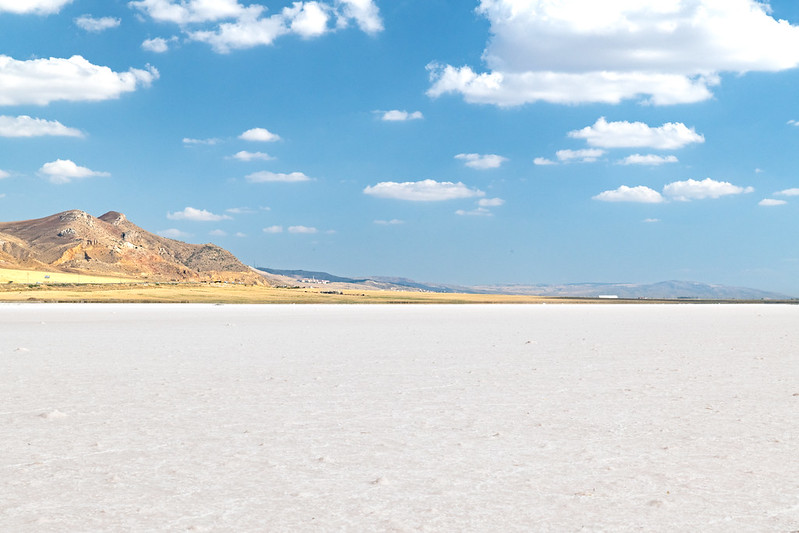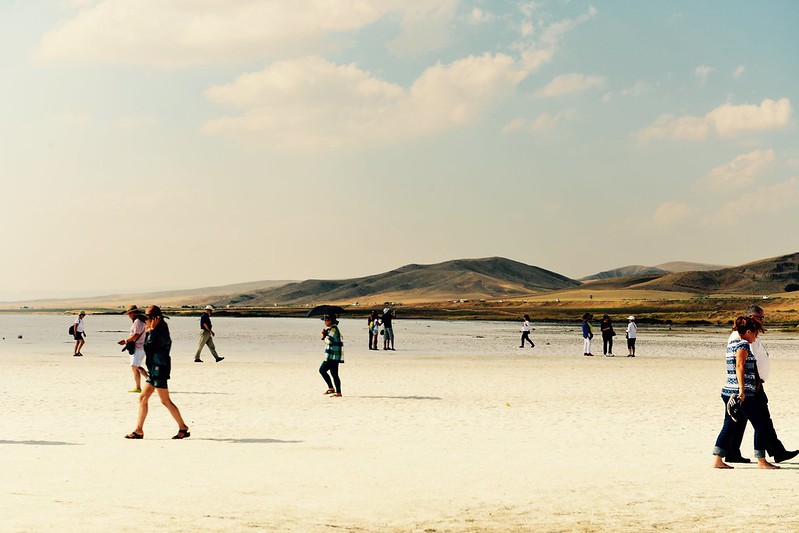With 1,665km2 of surface area, Lake Tuz is Turkey's second-largest lake, also one of the most hypersaline lakes in the world. Located in Central Anatolia Region at 105 km northeast from Konya, 150km south-southeast from Ankara, and 57km northwest of Aksaray, Turkey.
 |
| Lake Tuz |
Tuz Golu
Lake Tuz in Turkish "Tuz Gölü" means 'Salt Lake', and in Latin - Tatta Lacus. It is situated on Turkey's central plateau in a tectonic depression. It is fed by surface and groundwater, but it has no outlet. There are brackish marshes where streams and channels enter the lake. The lake is surrounded by arable fields, except the southwest and south where salt-steppe is abundantly seasonally flooded.
It is only 0.4m (1 ft) deep for most of the year. Winter sees part of the salt dissolve in the freshwater, which is brought to the lake through precipitation and surface runoff (to 324%0 salt). The lake dries out in summer, leaving an average salt layer of 30 cm thick in August. This is how salt mining takes place in the lake. 33% of Turkey's salt is produced by the three lake mines. The region is home to significant industrial activity, including salt processing and refining.
Turkey salt lake
Lake Tuz, pink salt flats was designated a special protected area in 2001. This includes the entire lake surface, waterbeds, and important steppe areas. A group of islands is the location of the main Turkish breeding colony for greater flamingo (Phoenicopterus Roseus) in the southern portion of the lake. The Greater White-fronted Goose (Anser Albifrons) is the second-largest breeder. In the surrounding villages, there is a common breeder of lesser kestrels (Falco numanni).
The lake was originally called Tatta and was situated on the border between ancient Lycaonia, Galatia, and Phrygia. It was later annexed by Lycaonia. According to ancients, the lake's waters were so infused with brine that anything that was dropped into them, was immediately coated with salt. Even birds flying close to the surface were encrusted with salt so that they could not rise into the air and be caught easily. Stephanus of Byzantium refers in Phrygia to a salt-lake he calls Attaea. Botieum was located near Botieum. This is most likely the same as Lake Tatta.
Image / Source
 |
| Tuz Golu |
Image / Source
 |
| Tuz |
Image / Source
 |
| Tuz gl |
Image / Source
 |
| Salt lake Ankara Turkey |
Image / Source
 |
| Largest lake in Turkey |
Image / Source
 |
| Tuzla gl |
Image / Source
 |
| Salt lake Turkey |
Image / Source
 |
| Turkey salt lake |
Image / Source
 |
| Pink salt lake |
Image / Source
 |
| Salt lake pink |
Image / Source
Source → Wikipedia

No comments:
Post a Comment